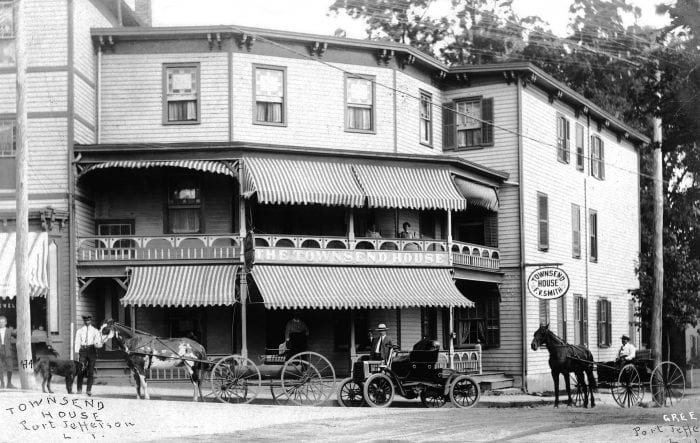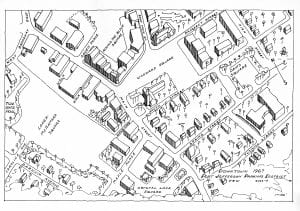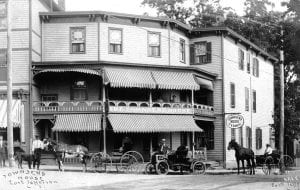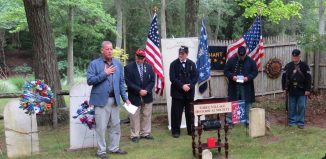Waking a Sleeping Lion: Port Jefferson and the Parking District Plan

By Kenneth Brady
Visiting the beautiful downtown Port Jefferson of today, it seems inconceivable that the village’s commercial center of the 1950s was thought to be dead, stagnant and depressing.
Businesses were leaving Port Jefferson and relocating along major highways and at malls, where in contrast to the village, there was adequate parking for customers.
Abandoned by some merchants, Port Jefferson’s shopping section was characterized in local newspapers as ramshackle and dilapidated.

Absentee landlords were lambasted for not razing structures that had been gutted by fire, particularly burnt-out properties along the village’s East Main Street and East Broadway, while indifferent businessmen were faulted for running drab, seedy stores with dirty, unimaginative window displays and dated, limited stock.
Making matters worse, heavy trucks rumbled through downtown Port Jefferson day and night hauling oil, sand, stone, gravel and fly ash from the various industries along the village’s waterfront. According to critics, the lumbering vehicles created noise, dust, spillage and traffic problems on the streets in Port Jefferson’s business district, driving potential customers away.
In 1957, the Port Jefferson Chamber of Commerce conducted a study to determine what could be done to revive the village’s ailing retail center and found that 87% of the shoppers surveyed were dissatisfied with parking conditions in Port Jefferson. The report called for enlarging public lots, routing trucks off Main Street, relocating store entrances and other suggestions.
In response to these recommendations, Brookhaven Town appropriated $20,000 in 1960 for a Parking District Committee to study the creation of a Port Jefferson Parking District. In 1961, the committee proposed the establishment of seven parking areas in the village including “Crystal Lake Square” and “Round the Block Square.”
The construction of these lots would have entailed the demolition of historic buildings in Port Jefferson’s downtown business district such as the Townsend House and Aldrich House both of which would have been razed and replaced with the asphalt of “Woodard Square.”
A public meeting was held at Port Jefferson High School on August 22, 1961 to present the plan and allow villagers to voice their reactions. Over 600 indignant residents attended and expressed their overwhelming opposition to the scheme that they believed would destroy the historic character of the community.
Many villagers were bothered by what they saw as the patronizing attitude of an “elite” that had decided that urban renewal, condemnation and eminent domain were best for Port Jefferson.
Residents were also insulted by the contents of a 132-page report that had been prepared for Parking District Committee members only, but had been leaked to the public, and had concluded that 30% of the homes in Port Jefferson were deteriorating, there were slum-like pockets within the village and Port Jefferson’s citizens were poor and aged.
While conceding that improvements were warranted and long overdue, many villagers were miffed that control over parking would have been placed in the hands of a distant Brookhaven Town Board in Patchogue, not the people who actually lived in Port Jefferson.
Brookhaven Town’s unwavering support of the parking plan, even as most villagers emphatically rejected the proposal, sparked the creation of the Port Jefferson Property Owners Association. Organized in September 1961, the civic group soon formed a committee to study incorporation.

The idea of home rule was not new to Port Jefferson. As early as 1895, the Ladies Village Improvement Society of Port Jefferson had called for incorporation, but the parking plan and an indifferent Brookhaven Town Board had prodded villagers into action and awakened a sleeping lion.
On Dec. 7, 1962, by a 2-1 margin, Port Jefferson’s residents voted to incorporate, deciding in favor of local control and the right to govern independent of Brookhaven Town.
The Parking District Plan was dead.
Kenneth Brady has served as the Port Jefferson Village Historian and president of the Port Jefferson Conservancy, as well as on the boards of the Suffolk County Historical Society, Greater Port Jefferson Arts Council and Port Jefferson Historical Society. He is a longtime resident of Port Jefferson.






